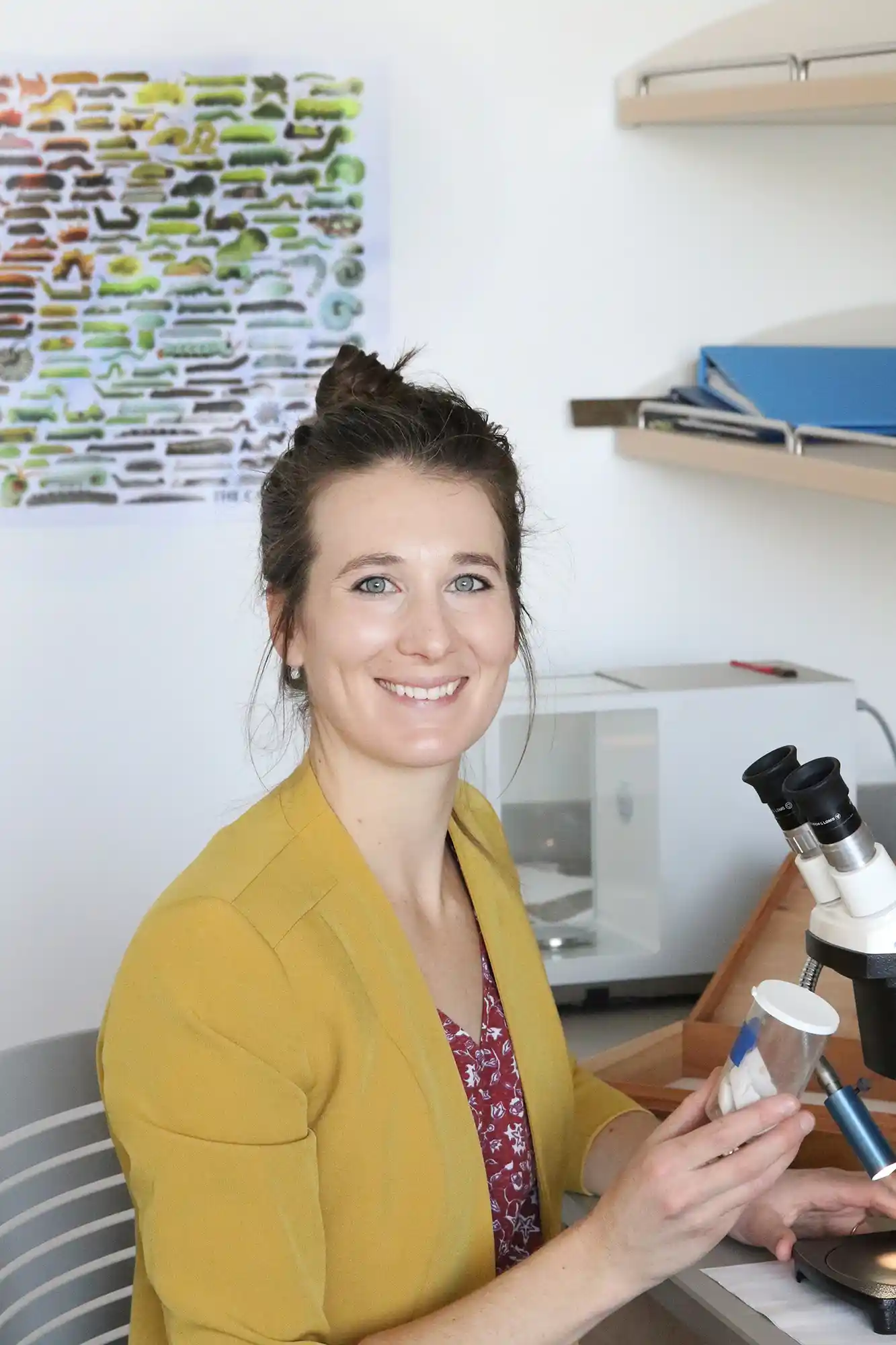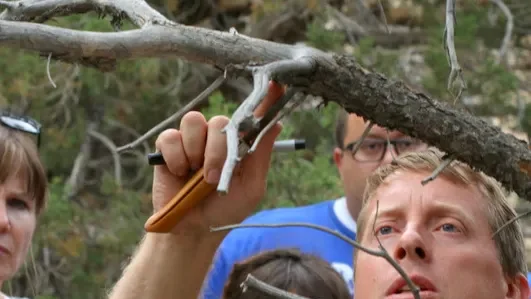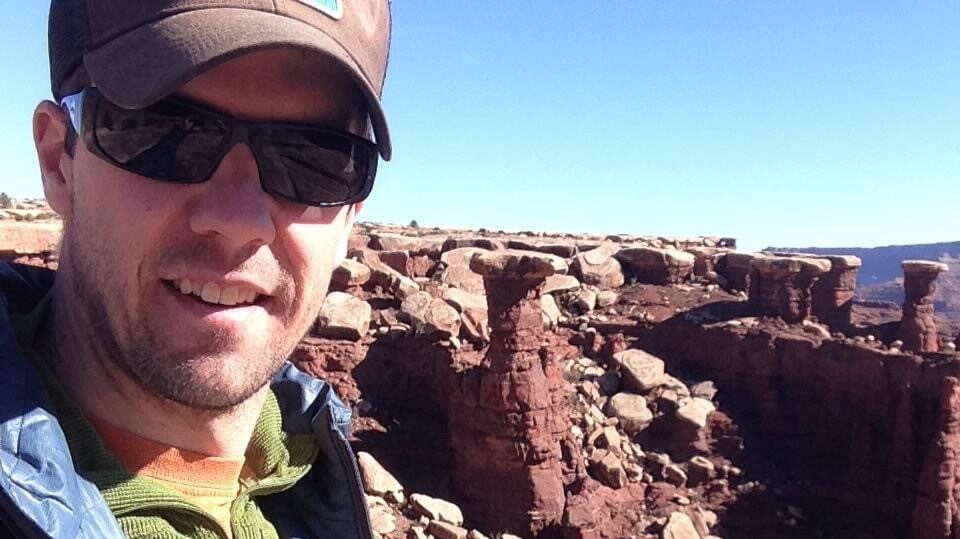Some information may be outdated.
Recently, Science Moab spoke with Moria Robinson, assistant professor of Biology at Utah State University, about plant and insect food webs. Changes in these food webs can be indicative of broader changes in climate.
Science Moab: Can you begin by describing what it means for a food web to be healthy?
Robinson: A lot of us probably learned about food webs in school, when we might have drawn out the relationships between different organisms and species that eat each other. These food webs are ways that we can map out how healthy ecosystems function, because the relationships between organisms that eat each other show us how energy flows through ecosystems. We need a certain number (or biomass, or abundance) of animals at the bottom of a food web to support animals at the top of a food web. We also need different safeguards in these food webs; for example, if a particular species disappears in a given year—maybe because its temperature or climate or food requirements aren’t met—we need to have another species in the web that can step in and fill that role. That species could [help to create stability in the web by] for instance, ensuring that the abundance of animals below it doesn’t get too large, which could then deplete other resources at the next level down, and it could also provide itself as a food resource to species higher up in the web. We look for diverse communities of animals, so that if one is gone in a given year, another can fill the role.
Science Moab: What are some causes that can lead to change in a food web?
Robinson: The way I like to think about this is from the bottom up. I think a lot about how plants allocate their energy among different functions that they have to do. Plants need to grow and reproduce, but they also need to defend themselves against getting eaten. Under stressful circumstances, what we often find is that plants will invest more in defense, because if they do get eaten [by insects] they won’t have a lot of resources like water or nutrients available to compensate and regrow from that.
In more stressful environments with lower precipitation and higher temperatures, plants may shift to investing more in defense [mechanisms], such as chemicals that are toxic to insects or leaf hairs that deter insects and make it harder for insects to eat the leaves. When this happens, we could see a number of different outcomes for the food web. For example, we might expect fewer insects to eat those plants [with the bulked-up defenses], but we also might predict that only specialized species of insects that are more able to counter those defenses will eat the plants. With changes like this, food webs might shift. The web might become more specialized, it might lose generalist insects as plants invest more in defense. And changes like these can have various outcomes for the stability of entire ecosystems, but that’s what we’re trying to understand. What are the changes we’ll see, and how will that influence the long term resilience of these complex food webs?
Science Moab: In your current project, what specific plants and/or insects are you studying?
Robinson: The organisms that get me the most excited are the larval forms of butterflies and moths. These are really amazing animals to think about in the context of food webs because they are eating plants and then they are getting eaten by a wealth of other species. The work I’m doing now is thinking about which plant species on the Colorado Plateau are most important for supporting robust and diverse populations of caterpillar species because that, in turn, is what supports birds, rodents, and so many other animals that together form a healthy ecosystem.
I’m also studying rubber rabbitbrush, Ericameria nauseosa. It’ll be familiar to many people by sight: it’s the silvery green plant that puts out incredible, golden displays of flowers in the fall, even into October. Rubber rabbitbrush is neat because it provides important food for caterpillars and for pollinators, so it links different kinds of ecosystem services (natural functions that benefit humans) to our landscape. It has a wide range: it grows across elevation in the Moab area and all across the West. It also grows in drier places and in wetter places. Some of the questions I’m asking are: first, how do variations in elevation, moisture, and soil fertility affect the characteristics of the plants that make them tastier to caterpillars or not? Second, how does that affect the abundance and diversity of caterpillars in those plants? And then, I’m measuring the different rates at which birds visit plants to look for caterpillars, and whether certain plant species—rabbitbrush, sagebrush, mountain mahogany—are more important than others in supporting birds.
Science Moab: So you’re measuring the caterpillars and birds visiting the rabbitbrush, but are you also monitoring changes in the rabbitbrush itself?
Robinson: Yes, we are very interested in looking at shifts in the plants themselves, which could happen in a few different ways. Rabbitbrush are long-lived perennial plants. We could have plants that persist in the same location and change their traits through time as the environment changes. So, [we might see] an individual rabbitbrush plant that responds to a drier year by manufacturing more chemicals in its tissue, for example. We would call that a plastic response, where the same individual responds differently to changing conditions.
But we could also see that certain individuals in the population might die out and [the area be reestablished] by other individuals [adapted to drier conditions] potentially moving up from the south. We would think about that as range expansion or range shift [a larger-scale change in the geographic boundaries of where rabbitbrush grows]. We do have plans to try to monitor those changes through time and then try to understand what the consequences of those changes are for the rest of the ecosystem.
Appreciate the coverage? Help keep local news alive.
Chip in to support the Moab Sun News.





